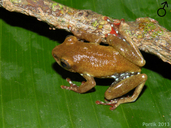|
Hyperolius pardalis Laurent, 1948
| family: Hyperoliidae genus: Hyperolius |
 © 2013 Daniel Portik (1 of 5) |
|
|
|
Description This species is similar to H. bolifambae, from which it differs by the more numerous dorsal spots, and larger gular flap. It is also very close to H. steindachneri, of which it is often regarded as a subspecies. The tadpole has the typical shape and tooth formula for the genus. Distribution and Habitat Country distribution from AmphibiaWeb's database: Cameroon, Central African Republic, Congo, Congo, the Democratic Republic of the, Gabon
Life History, Abundance, Activity, and Special Behaviors Comments This account was taken from "Treefrogs of Africa" by Arne Schiøtz with kind permission from Edition Chimaira publishers, Frankfurt am Main.
References
Schiøtz, A. (1999). Treefrogs of Africa. Edition Chimaira, Frankfurt am Main. Originally submitted by: Arne Schiøtz (first posted 2001-01-10) Edited by: Kellie Whittaker (2008-09-10) Species Account Citation: AmphibiaWeb 2008 Hyperolius pardalis <https://amphibiaweb.org/species/560> University of California, Berkeley, CA, USA. Accessed May 30, 2025.
Feedback or comments about this page.
Citation: AmphibiaWeb. 2025. <https://amphibiaweb.org> University of California, Berkeley, CA, USA. Accessed 30 May 2025. AmphibiaWeb's policy on data use. |



 Map of Life
Map of Life